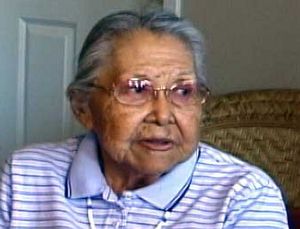Emily Waheneka facts for kids
Emily Waheneka (1919-2008) was a talented Native American artist. She belonged to the Warm Springs, Wasco, and Paiute tribes.
Emily Waheneka was especially known for her amazing beadwork. She used traditional Sahaptin designs, which are unique to tribes like the Warm Springs, Yakima, and Umatilla. Her mother and grandmother, who were also beadworkers, greatly influenced her art. Emily was also very active in her community and the Waashat religion.
She created many beautiful items. These included beaded bags, tobacco pouches, and special ceremonial clothing. She made buckskin dancing outfits like wing-dresses and ribbon shirts. She even designed patterns for Pendleton coats.
Long ago, around 1805, European traders brought beads to Native peoples. These beads came in many colors and became important for trade. Native American artists, including the Sahaptin peoples, started using them. They created their own special beadwork styles with simple, bold designs.
Emily Waheneka helped keep her people's art and history alive by teaching others. Her artwork is displayed in many private collections. You can also see her pieces in museums. These include The Museum at Warm Springs in Oregon and the Museum of Northwest Art. She taught traditional Native beadwork and was certified by the Native American Arts & Crafts council.
Early Life and Learning
Emily Waheneka was born on February 11, 1919, in Simnasho, Oregon. Her Native name was Kis-Sun-Y. Her mother, Annie Anderson Pewee, was also a skilled beadworker and weaver. Emily's father, Howard George Henning, passed away before she was born.
Emily started learning to sew when she was just six years old. Her elders, especially her mother and grandmother, taught her many traditional art forms. They showed her how to prepare deer hides. She learned to make buckskin gloves, moccasins, and vests. She also learned to weave corn husk bags and sew with needles and thread.
Her first language was Sahaptin. In 1925, she began learning English at an Indian boarding school. By age 12, she started working as a waitress. During the summer, she continued to improve her sewing, beading, and hide-tanning skills.
During World War II, Emily worked as a certified welder in shipyards. She was chosen to fix leaks on large ships like tankers and landing crafts. After the war, she worked as a baker and cook at an Indian boarding school. She also helped in hospitals as a nurse's aide.
On November 13, 1951, she married Air Force Sergeant Grant Waheneka. For the next 20 years, she lived on Air Force bases. In 1963, after her husband retired, they moved back to Warm Springs. They adopted their son, Dolan, when he was four years old. Their daughter is Marjorie Williams Waheneka. Emily and Grant had many grandchildren.
Artistic Career
Emily Waheneka was deeply involved in the cultural life of her Washat community. She created many beaded items for ceremonies, dancing, and daily use. She made complete traditional buckskin dancing outfits for men and women. These outfits included fancy beaded aprons, hair pieces, and medallions. She also designed side purses and tobacco pouches.
Emily also created designs for Pendleton coats and jackets. She made ribbon shirts and wing dresses. These were worn at ceremonies and pow-wows. In 1990, she designed a fully beaded dance cape for Miss Warm Springs.
She was known for her excellent craftsmanship and unique style. Her drawings, complex designs, and use of color were highly praised. She created her own abstract and detailed designs. Some of her bead designs had been passed down through generations.
Emily often used tiny, imported cut glass beads for her detailed portraits of Native people. Some of these beads were very small, like sizes #14, #16, and #18. These special beads are no longer made today. They were imported from places like Czechoslovakia and Italy. Emily was able to make her portrait medallions look three-dimensional. This was very unusual for Native American beadwork.
Emily often gave advice to people who wanted to buy high-quality traditional and modern beadwork. She also helped other Native artists sell their creations.
Awards and Recognition
In 1993, Emily Waheneka received a special honor. She was given the Women's Caucus for Art Lifetime Achievement Award. This award recognized her lifelong contributions to art.
When she was 86, Emily was interviewed for a project called the Lewis and Clark Rediscovery Project. This project was done by the University of Idaho. In her interview, she shared important historical information about her people.
Exhibitions
Emily Waheneka's artwork was shown in a special exhibition. It was called Washington Voices in Contemporary Sculpture. This exhibition took place at the Bellevue Arts Museum. It ran from January to March in 1993.
Collections
Emily Waheneka's work is part of the permanent collections at several museums. You can find her pieces at The Museum at Warm Springs and the Museum of Northwest Art. Most of her works are still with the Paiute people. Tribal members have received her beautiful beadwork as gifts during traditional give-away ceremonies.


